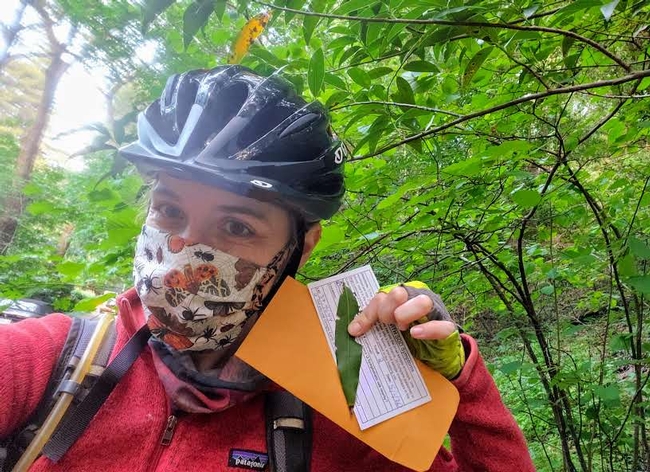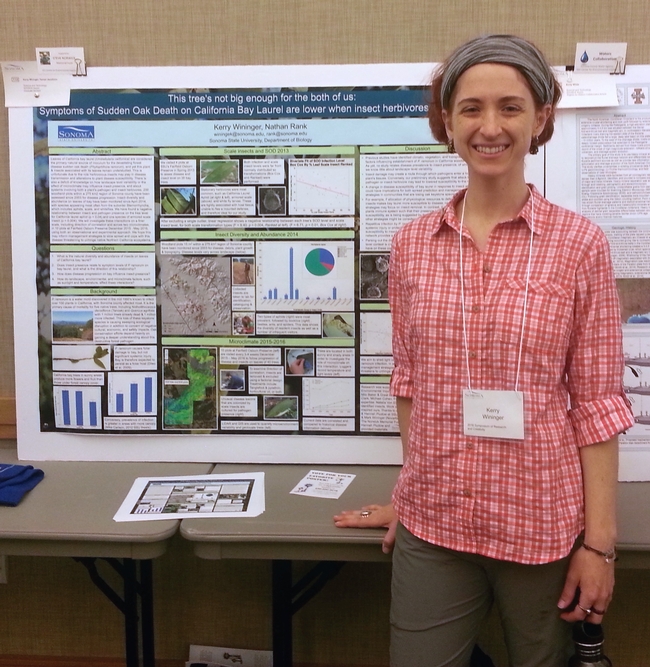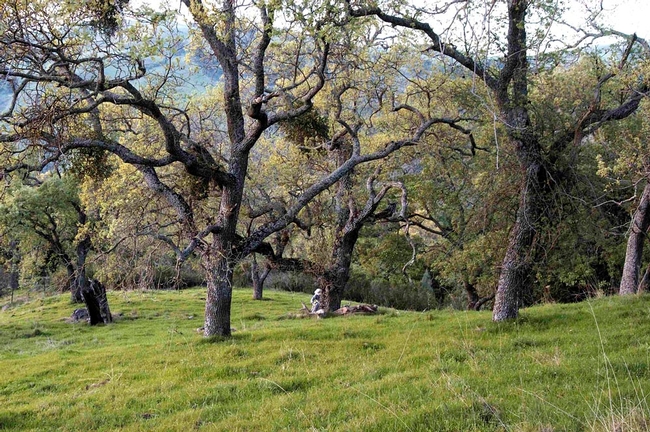- Author: Kerry Wininger
- Editor: Karen Giovannini
Sonoma county residents love their oak trees, and with good reason: Oak woodlands are a source of immense value not just to the more than 330 types of animals and hundreds of other organisms they support, but also to the cultural, economic, and social fabric of our society. Sudden oak death (SOD) threatens to unhinge these systems, imperil biodiversity, create hazard trees or fuel for fires, and potentially infect agriculturally or horticulturally important plants. So whether it means adapting educational events to virtual spaces, delivering materials by mail, training online, answering home phones instead of staffing the Master Gardener desk, or collecting leaves for the SOD blitz by bicycle while wearing a mask and social distancing, the UCCE Sonoma SOD Program is not letting COVID-19 slow us down.
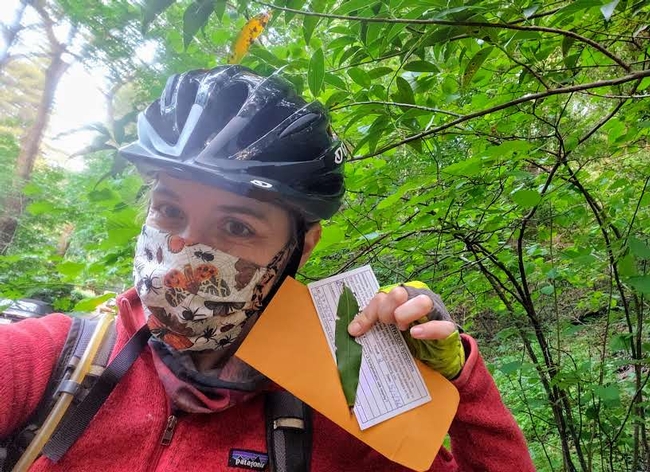
A key endeavor of this group is the yearly Sudden Oak Death Blitz in partnership with UC Berkeley's Forest Pathology and Mycology Lab. This state-wide citizen science project allows landowners to receive free testing of California bay laurel and tanoak leaves, contribute to long-term scientific research, and update the SOD Map Mobile app used by landowners and professionals to assess disease risk in their area. As SOD Blitz creator Dr. Matteo Garbelotto wrote in a letter addressed to all Californians about this year's program,
“The SOD Blitzes have become a tradition for many, while providing key information to help us save our oaks from a devastating disease.”
UCCE Sonoma hosts six blitz events annually whereas most counties hold just one, and we were eager to test new areas of tree mortality that were discovered after last-year's blitz had already passed. Here's how we made it work:
- Training took place online.
- Three Zoom sessions were set up with SOD team members for participant questions.
- Collection packets were mailed to most participants, and the rest picked up following strict safety guidelines supervised by staff.
- Leaves were collected at homes and on public land by walkers, cyclists, and others engaging in outdoor exercise.
- Kashia Pomo staff continued to sample on their land.
- In collaboration with SSU's Center for Environmental Inquiry, we hosted the only SOD blitz in the state that was fully bilingual in Spanish and English.
Despite limitations posed by COVID-19 regarding how to train volunteers, access areas where leaves could be sampled, and safely pass materials and samples between participants and blitz organizers, this year's campaign is on track to be even more successful than 2019. Returning leaves by mail instead of in-person allowed residents on the coast and other remote areas to participate easily, leading to a better geographic distribution of sampling. Online trainings and Q&A sessions, though less personal and lacking physical demonstrations, encouraged people with schedule constraints to give the blitz a try. One participant with extra time on his hands reported that he thought this was a great way to give back to the community in a time of need. Based on the number of participants and collection packets requested, we estimate a 15% increase in sampling from last year, including all major areas of Sonoma county and most of Mendocino county.
And things are just getting started. Though a SOD-themed Plant Walk with the local Milo Baker chapter of the California Native Plant Society was postponed, discussions are underway about creating a live virtual field trip in its place, complete with 360 degree photos of highlighted spots along the trail. Similarly, SOD Specialist Master Gardeners have been presenting at public library series' for years, and are now hoping to create a recorded version to be posted on UCCE Sonoma's Sudden Oak Death webpage. Check back for announcements on these and other happenings.
Our gratitude goes out to every volunteer who has invested their time in staying educated, spreading the word, and participating in citizen science with us over the years, especially during the current shelter-in-place, with special recognition for our dedicated team of SOD Specialist Master Gardeners. We couldn't help our oaks without you!
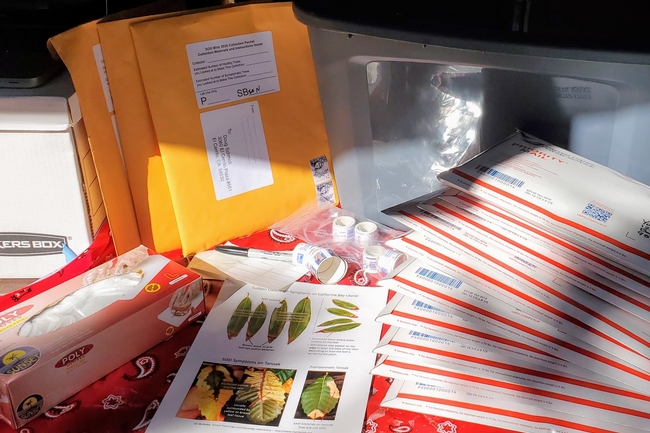
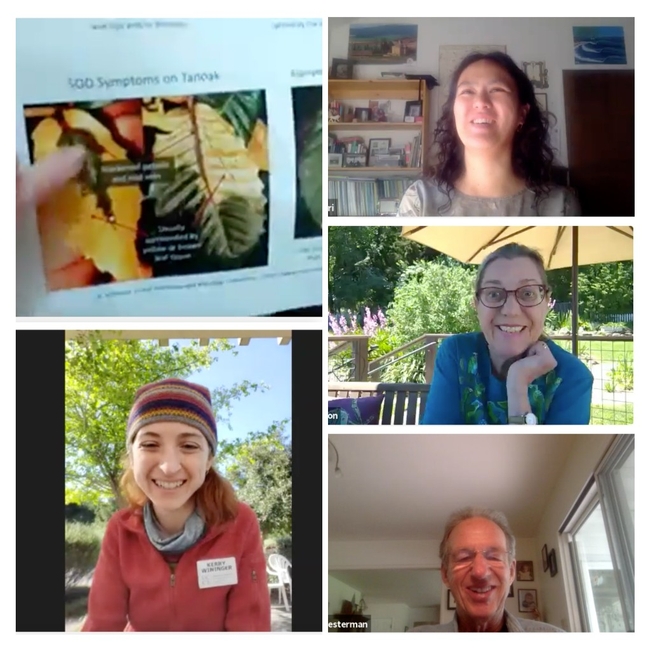
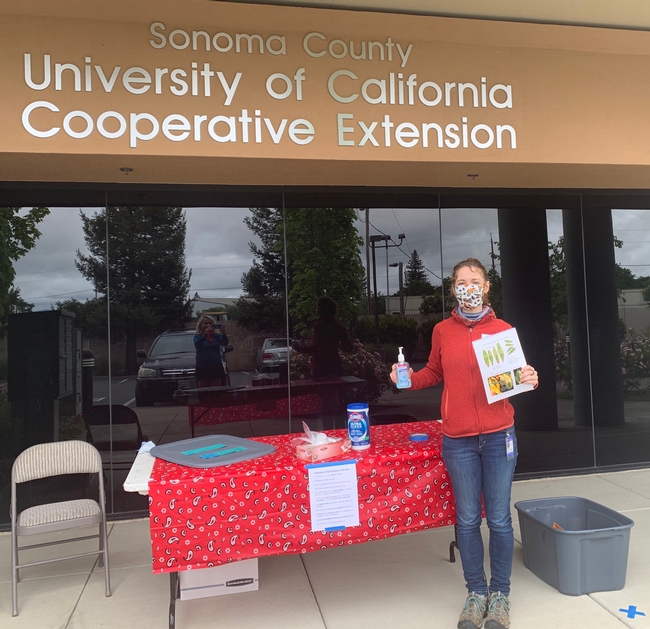
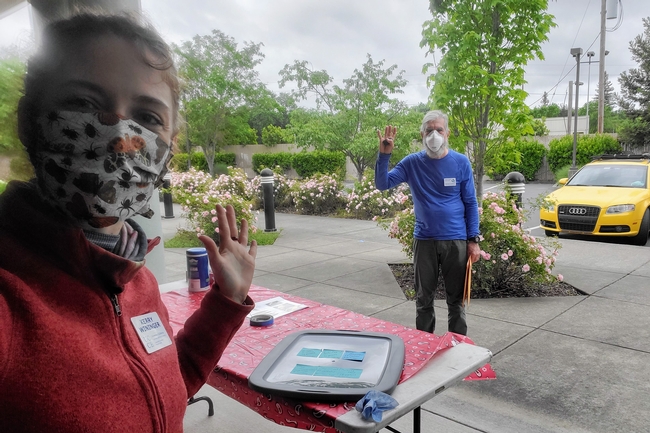
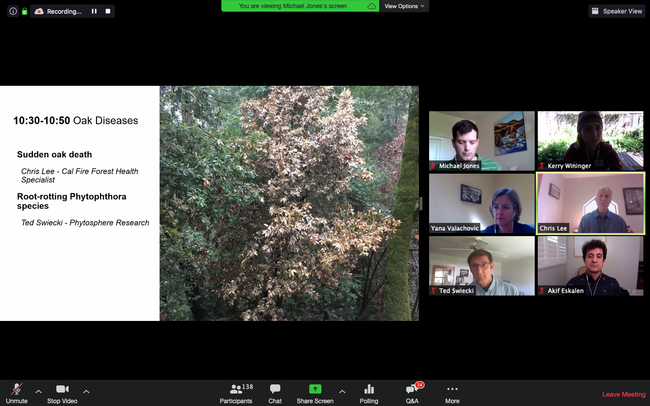
- Author: Kerry Wininger
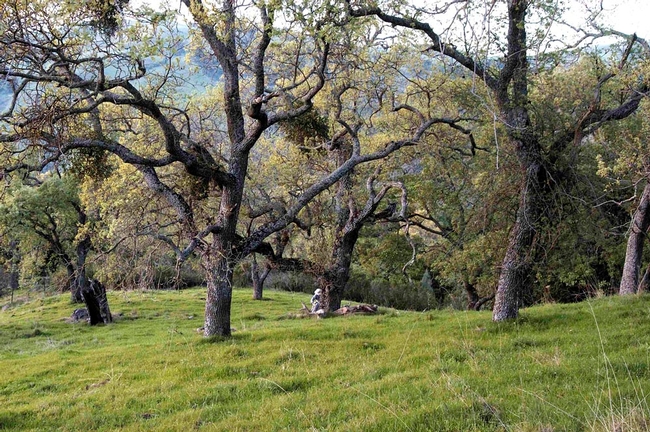
The dichotomy is real. Annually since 2006, Garbelotto's Lab has run a successful state-wide citizen science “SOD Blitz” campaign in each infested or at-risk California county; UCCE Sonoma coordinates this county's efforts. Volunteers in the community, from high schoolers to retirees, collect symptomatic leaves of the two trees most likely to spread the disease to oaks, California Bay Laurel and Tanoak, then Garbelotto's lab tests them. Results from the most recent Blitz show the largest increase in cases of Bay and Tanoak infections by Phytophthora ramorum, the causal agent of SOD, since the surveys began3.
|
What you can do:
|
The estimated true infection rate of Sonoma county trees more than doubled since just last year. A new outbreak has appeared in the coastal area of northern Sonoma County, and infections have re-emerged in areas from which the disease had previously retreated during the drought. Further afield is the most striking, and discouraging, discovery from last year's Blitz – multiple infections were detected in San Luis Obispo, more southerly than ever previously documented, paving the way to add a 16th county to those listed as infected in the state. Infection was also observed in the hot eastern vicinity of Ukiah for the first time, startling researchers who are accustomed to the pathogen's preference for moist, cool areas. Other findings include two new possible host species in the San Francisco Botanical Garden at Strybing Arboretum, the first detected infections on Mt. Diablo in Contra Costa County, and an outbreak in southern coastal Mendocino County.
On the upside, substantially more trees were tested during this last blitz than in recent years, novel areas were sampled, and new participants joined the ranks of Citizen Scientists. New treatment recommendations out of the Garbelotto Lab show promise in helping individual trees more safely and effectively decrease their chances of infection if done so before exposure to the pathogen4.
Why should land owners and managers, businesses, and the public care? Sudden Oak Death poses many apparent threats as well as those that are less obvious. The dramatic loss of oaks and tanoaks impacts biodiversity, nutrient and water cycling, forest microclimate, wildlife, and erosion. There is the potential for increased fire risk and severity in areas with dead and downed trees, creating a safety hazard (Forrestel et al. 2015). Recreation in forests is altered (Kliejunas 2010). Traditional cultural practices are impacted. Even human health concerns such as transmission of Lyme Disease have the potential to increase (Swei et al. 2010). Lastly, economic consequences of SOD to land owners, municipalities, nurseries, and industry are estimated in the tens or even hundreds of millions of dollars (US GEO 2006).
Now, more than ever, it's important for scientists, educators, professionals, and the community to come together. Though the news is disheartening, and attention may be elsewhere, collectively we can help slow the spread and cope with this disease that threatens to unhinge native California ecosystems and all that they impact.
Kerry is the new Sudden Oak Death Program Coordinator for UCCE Sonoma County, “I enthusiastically follow in the footsteps of the esteemed Lisa Bell, and am already in awe of the great work the Master Gardener SOD team does. I am eager to help get the word out about this challenge and how to face it, and hope to implement new ideas related to SOD content in environmental education and trainings for tree care professionals.” Kerry has an undergraduate degree in Biology from UC Berkeley, and has worked with various environmental organizations as a researcher, educator, naturalist, and communicator while pursuing a Masters Degree on SOD and insect herbivores of bay at Sonoma State University. She has presented research at conferences, such as last summer's SOD6 Symposia in San Francisco that garnered international attention5, and the California Forest Pest Council Annual meeting that this year focused much more on drought-induced beetle attacks in the Sierras than it did on SOD6.
If you are interested in learning more or getting involved, please contact Kerry Wininger kwininger@ucanr.edu.
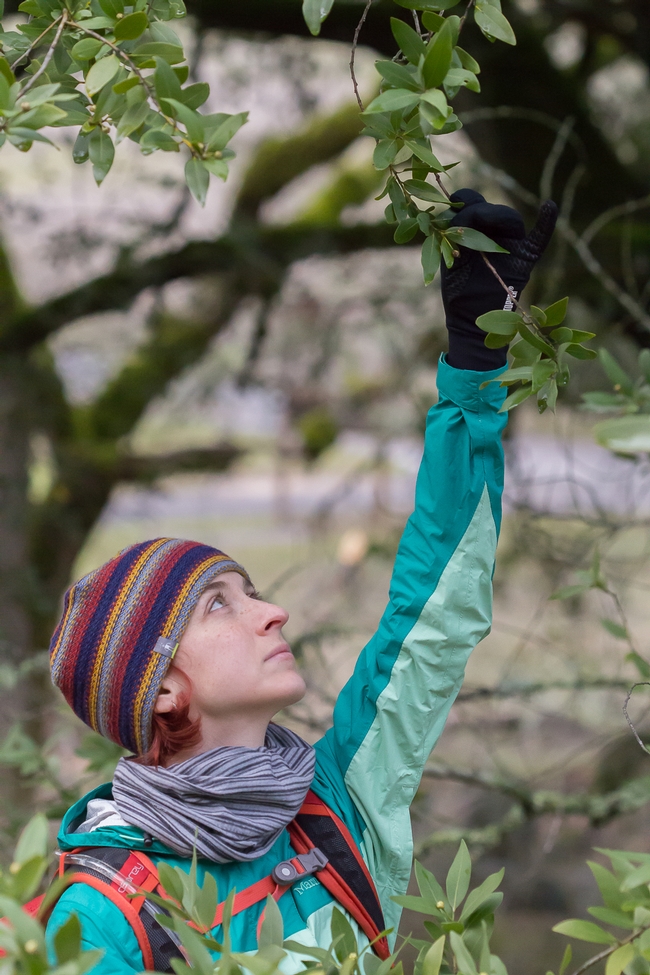 Fieldwork: Kerry Wininger assessing symptoms of Sudden Oak Death on a California Bay Laurel tree at Fairfield Osborn Preserve on Sonoma Mountain January 2016 |
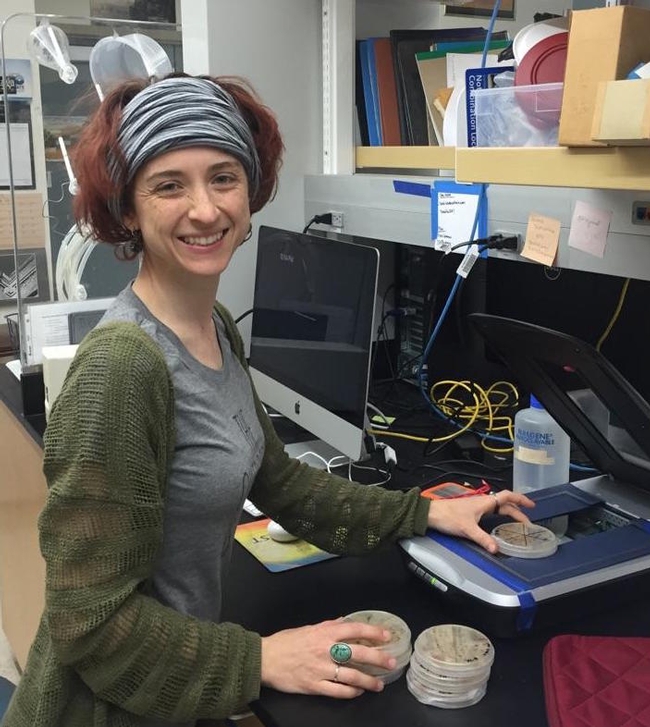 Kerry in the lab |
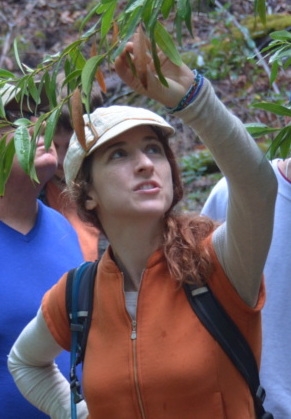 Kerry giving a tour |
|
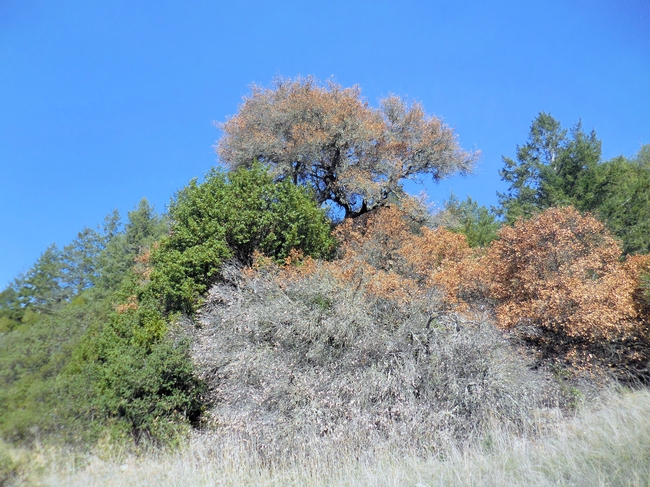
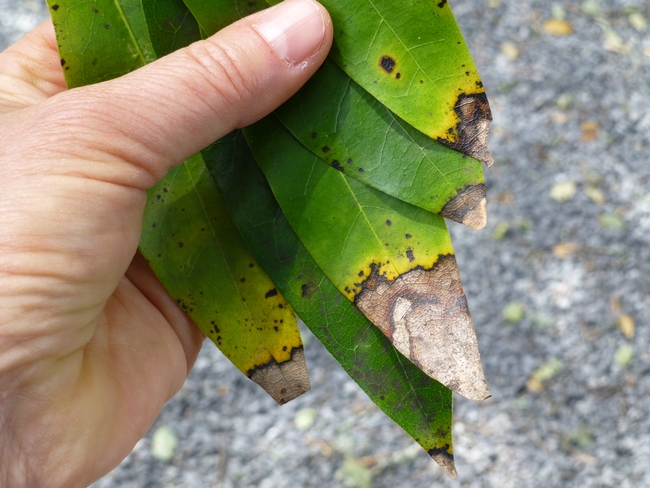
1. Drought slows spread of sudden oak death in Sonoma County, The Press Democrat, Sept 29, 2015
2. Sudden oak death in Sonoma County explodes, thanks to winter rains, The Press Democrat, Oct 18, 2016
3. Largest Sudden Oak Death Expansion in California in a Decade, CA Oak Mortality Task Force, Oct 14, 2016
4. SOD Disease Management, UC Berkeley Forest Pathology & Mycology Lab, Oct 20, 2016
5. SOD 6th Science Symposium, UCANR, June 21-23, 2016
6. 2016 California Forest Pest Council Annual Meeting Presentations
7. SOD, UC Master Gardener Program of Sonoma County
8. TreeFAQs, UC Berkeley Forest Pathology & Mycology Lab
Bibliography
Forrestel, AB, Ramage, BS, Moody, T, Moritz, MA, Stephens, SL. 2015. "Disease, fuels and potential fire behavior: Impacts of Sudden Oak Death in two coastal California forest types." Forest Ecology and Management, 348: 23-30.
(GAO) US Government Accountability Office, 2006. Invasive Forest Pests: lessons learned from three recent infestations may aid in managing future efforts. Report from the United States Government Accountability Office to the Chairman, Committee on Resources, House of Representatives.
Kliejunas, JT. 2010 Sudden oak death and Phytophthora ramorum: a summary of the literature. US Department of Agriculture, Forest Service, Pacific Southwest Research Station: General Technical Report PSW-GTR-234.
Swei, A; Ostfeld, RS.; Lane, RS.; Briggs, CJ. Oecologia. 2011. Effects of an invasive forest pathogen on abundance of ticks and their vertebrate hosts in a California Lyme disease focus. 166(1):91-100.
- Author: Lisa Bell

Garbelotto presented guidelines for California bay tree removal—the first defense in preserving your susceptible oak trees—as well as dosage changes in chemical treatments for oaks.
SODMAP Mobile is an app for tracking SOD. This App calculates the risk to your oaks based on real SOD monitoring data. In Sonoma County, these data are created mainly by the public each spring during the SOD BLITZ, an educational, data-collecting weekend led by the Sonoma County SOD program coordinator, Lisa Bell, and the UC Master Gardeners.
SODMAP Mobile for iPhone
SODMAP Mobile for Android
Photo from SODMAP Mobile shows infected trees, marked with red pins, along a road near Freestone, Sonoma County.
Learn more about Sudden Oak Death in Sonoma County.
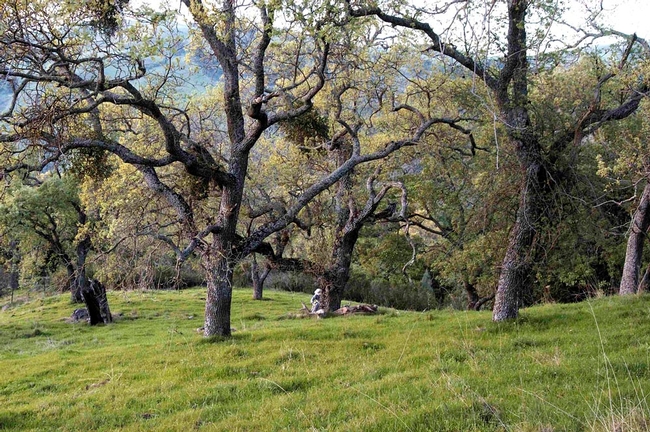
- Author: Lisa Bell
A Citizen Science Project
What is the Sudden Oak Death Blitz?
- Spend one hour learning basic disease biology and how to identify it in the field, making you an expert
- Receive all necessary collection materials and instructions on how to sample. Note that sampling has to happen 1-2 days after the training
- Spend 1-4 hours on your own in a location of your choice (your property, business, favorite forest or campground) looking for disease symptoms and collecting symptomatic leaves
- Click here to Register for this free event
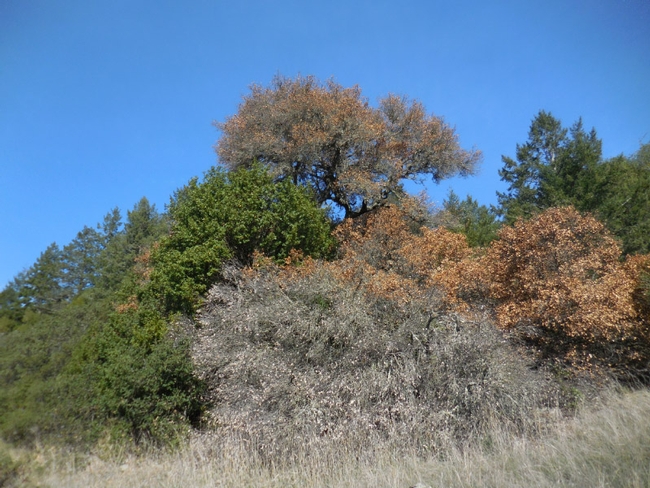
You will become officially a citizen scientist and your published disease distribution data will help save our oaks. All at no cost to you. Tree care specialists attending the training can bring in clients' samples.
Meeting Locations
10-11 a.m. Saturday May 30, 2015.
Santa Rosa: Spring Lake Park Environmental Discovery Center. Use park entrance at Violetti Drive, upper parking lot. 393 Violetti Drive, Santa Rosa, CA 95409
Graton: Graton Community Club at Main and N Edison in Graton. Map and Directions.
Cloverdale: Cloverdale Historical Society, 215 N Cloverdale Blvd. Map and Directions.
This is a free event. Register here.
Oaks become at risk if the disease is within 200 yards from them!
Find out if SOD is 200 yards away, here's how.
A message from Matteo Garbelotto, SOD Researcher, UC Berkeley: Many of our tree species are susceptible to SOD and several oak species and tanoaks can be killed in large numbers; in the worst sites 70-100% of trees are dead. Since its introduction, the disease has been spreading slowly but steadily and now it is present in 15 contiguous counties from Humboldt to Monterey. In about 15 years of research we have found several effective control measures, but these need to be applied before oaks are infected. Oaks become at risk exclusively if the disease is within 200 yards from them!!
Each year there is a massive surveying effort organized by U.C Berkeley with the help of organizations such as UCCE, the California Native Plant Society and the US Forest Service. This effort represents one of the strongest and now prolonged "citizen science" effort not only in the State, but in the whole country. The volunteer-based surveys have been dubbed SOD BLITZES and we are asking you to join the effort: we need your help to track this tree killer. All data generated by the BLITZES is made public through the web on SODmap Project, the SODmap Mobie app and the media. Learn More
- Author: Matteo M. Garbelotto
One of the greatest assets of our State is no doubt the vastness and richness of our natural environment. Unfortunately, such vastness is constantly being eroded by both natural and human-induced events. Sudden Oak Death aka SOD is one of those environmental threats belonging to the second category, having been introduced in the latter part of last century from an unknown location outside of North America. Many of our tree species are susceptible to SOD and several oak species and tanoaks can be killed in large numbers: in the worst sites 70-100% of trees are dead.
Since its introduction, the disease has been spreading slowly but steadily and now it is present in 15 contiguous counties from Humboldt to Monterey: in about 15 years of research we have found several effective control measures, but these need to be applied before oaks are infected. Oaks become at risk exclusively if the disease is within 200 yards from them!! That is the good news.
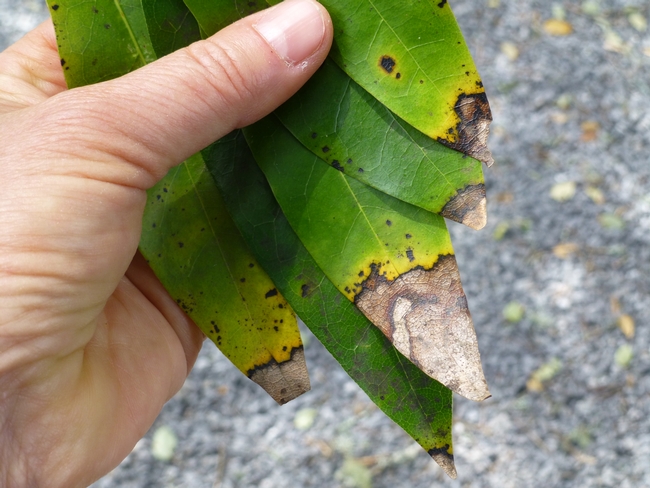
For the past 9 years citizens like you have been helping, and this help has resulted in the identification of several new outbreaks and in the eradication of some of these outbreaks. If your county is not extensively colonized by the disease, your effort will allow to exactly pinpoint its current distribution. This means knowing where extra care is warranted to avoid further spreading SOD, and knowing where business and leisure can be enjoyed without risking further disease spread. The volunteer-generated database is the most complete database for a forest disease anywhere in the world, including almost 20.000 points.
If you join a SOD BLITZ you:
- Will spend one hour learning the basic biology of the disease and how to identify it in the field, making you an expert
- Receive all the necessary collection materials and instructions on how to sample. Note that sampling has to happen 1-2 days after the training
- Spend 1-4 hours on your own in a location of your choice (your property, business, favorite forest or campground) looking for disease symptoms and collecting symptomatic leaves
- The activity is enjoyed by adults and children, btw it is a great school project
- You will become officially a citizen scientist and your published disease distribution data will help save our oaks. All at no cost to you
- Tree care specialists attending the training can bring in clients' samples
The SOD Blitz is in the spring because that is the time when SOD symptoms are easiest to spot. You can join and then sample wherever you desire in coastal California.
Register here for this free event
Date of SOD Blitz: May 30th, 10-11 am
- Graton—Graton Community Club, Main and N. Edison, Graton, CA
- Santa Rosa—Spring Lake Park Environment Discovery Center, 393 Violetti Road Park Entrance, Santa Rosa, CA
- Cloverdale—Cloverdale Historical Society, 215 N. Cloverdale Blvd., Cloverdale, CA
Contact: Lisa Bell
Author: Matteo M. Garbelotto


